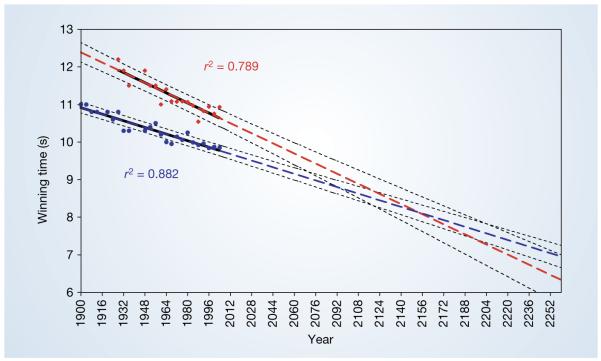The 2004 Olympic women’s 100-metre sprint champion, Yuliya Nesterenko, is assured of fame and fortune. But we show here that — if current trends continue — it is the winner of the event in the 2156 Olympics whose name will be etched in sporting history forever, because this may be the first occasion on which the race is won in a faster time than the men’s event.
The Athens Olympic Games could be viewed as another giant experiment in human athletic achievement. Are women narrowing the gap with men, or falling further behind? Some argue that the gains made by women in running events between the 1930s and the 1980s are decreasing as the women’s achievements plateau1.Others contend that there is no evidence that athletes, male or female, are reaching the limits of their potential1,2.
In a limited test,we plot the winning times of the men’s and women’s Olympic finals over the past 100 years (ref. 3; for data set, see supplementary information) against the competition date (Fig. 1). A range of curve-fitting procedures were tested (for methods,see supplementary information), but there was no evidence that the addition of extra parameters improved the model fit significantly from the simple linear relationships shown here. The remarkably strong linear trends that were first highlighted over ten years ago2 persist for the Olympic 100-metre sprints. There is no indication that a plateau has been reached by either male or female athletes in the Olympic 100-metre sprint record.
Figure 1.
The winning Olympic 100-metre sprint times for men (blue points) and women (red points), with superimposed best-fit linear regression lines (solid black lines) and coefficients of determination. The regression lines are extrapolated (broken blue and red lines for men and women, respectively) and 95% confidence intervals (dotted black lines) based on the available points are superimposed. The projections intersect just before the 2156 Olympics, when the winning women’s 100-metre sprint time of 8.079 s will be faster than the men’s at 8.098 s.
Extrapolation of these trends to the 2008 Olympiad indicates that the women’s 100-metre race could be won in a time of 10.57±0.232 seconds and the men’s event in 9.73±0.144 seconds. Should these trends continue, the projections will intersect at the 2156 Olympics, when — for the first time ever — the winning women’s 100-metre sprint time of 8.079 seconds will be lower than that of the men’s winning time of 8.098 seconds (Fig. 1). The 95% confidence intervals,estimated through Markov chain Monte Carlo simulation4 (see supplementary information), indicate that this could occur as early as the 2064 or as late as the 2788 Games.
This simple analysis overlooks numerous confounding influences, such as timing accuracy,environmental variations,national boycotts and the use of legal and illegal stimulants. But it is also defended by the limited amount of variance that remains unexplained by these linear relationships.
So will these trends continue and can women really close the gap on men? Those who contend that the gender gap is widening say that drug use explains why women’s times were improving faster than men’s, particularly as that improvement slowed after the introduction of drug testing1.However, no evidence for this is found here. By contrast, those who maintain that there could be a continuing decrease in gender gap point out that only a minority of the world’s female population has been given the opportunity to compete (O. Anderson, www.pponline.co.uk/encyc/0151.htm).
Whether these trends will continue at the Beijing Olympics in 2008 remains to be seen. Sports, biological and medical sciences should enable athletes to continue to improve on Olympic and world records, by fair means or foul5. But only time will tell whether in the 66th Olympiad the fastest human on the planet will be female.
Supplementary Material
Footnotes
Supplementary information accompanies this communication on Nature’s website.
Competing financial interests: declared none.
References
- 1.Holden C. Science. 2004;305:639–640. doi: 10.1126/science.305.5684.639. [DOI] [PubMed] [Google Scholar]
- 2.Whipp BJ, Ward SA. Nature. 1992;355:25. doi: 10.1038/355025a0. [DOI] [PubMed] [Google Scholar]
- 3.Rendell M, editor. The Olympics: Athens to Athens 1896–2004. Weidenfeld and Nicolson; London: 2003. pp. 338–340. [Google Scholar]
- 4.Gilks WR, Thomas A, Spiegelhalter DJ. Statistician. 1994;43:169–178. [Google Scholar]
- 5.Vogel G. Science. 2004;305:632–635. doi: 10.1126/science.305.5684.632. [DOI] [PubMed] [Google Scholar]
Associated Data
This section collects any data citations, data availability statements, or supplementary materials included in this article.



